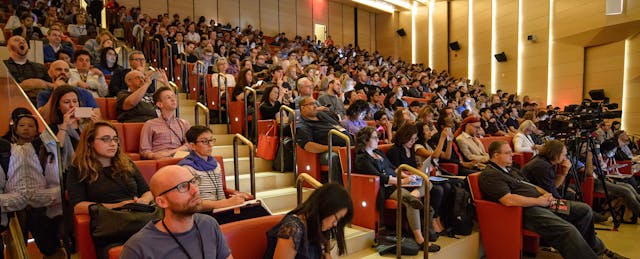The 14th gathering of the Games for Change Festival brought together developers, researchers, academics, a smattering of teachers and general gaming enthusiasts around a common goal: to celebrate and learn from video games that teach, heal, and communicate diverse perspectives. Event organizers estimate more than 100 speakers and close to 1,000 attendees showed up.
The event had no shortage of ideas that pushed the boundaries of the rich experiences that games can bring. Finalists for the Festival’s annual game awards tackled not just conventional school subjects like math, but little-known historical episodes such as the 1979 Iranian Revolution, the 2014 Israel-Gaza conflict and philosopher Henry David Thoreau’s experiment at Walden Pond. (And yes, Minecraft Education featured prominently as well.)
Yet against the dazzling games showcase and the design lessons that their creators shared, a hard but familiar reality set in: where is the support—from funders, from buyers—to keep these efforts financially sustainable?
The event has consistently attracted attendees with game design and research acumen throughout its 14-year history, notes Dan White, CEO of Filament Games. (He estimates he’s been to over 10 of these events.) Yet for those building educational games, one voice that’s been lacking—and sorely needed, he says—are “the administrators and educators who are in charge [and] making purchasing decisions.”
Without looping in the demand side of the educational market, the learning games industry can be vulnerable to big funders, whose support can be fickle at best. When I attended the Festival in 2013, Amplify (then owned by News Corporation) was the darling of the show, trotting out more than a dozen indie game developers to show off their educational games. (Many of them are now owned by TouchPress.)
Gone this year is the “soft” money in the form of grants and money from foundations, observes White. GlassLab, a nonprofit backed by the MacArthur Foundation and Gates Foundation to build learning games, assessment dashboards and a distribution portal, used to feature prominently in the event but has since been in limbo. (There was speculation abuzz about who will take over GlassLab’s assets, which are currently owned by Collective Shift.)
The mainstream gaming industry’s support for social impact and educational games have also been muted. In 2014 Valve teased plans to actively introduce its popular puzzle game, Portal 2, into schools. Last year, Sid Meier, the mastermind of the popular Civilization series, announced “Civilization Edu” to fanfare. Nary a peep from either party has been heard since.
Still, the Festival’s continued run is an ode to a diehard community that has weathered through hype cycles, funding swings and the continued skepticism over the value of games. But here’s why you should believe.
10 Studies to Know
Hardly anyone present at the conference needed much convincing about the potential of games to delight, educate and heal. Yet that’s still not the case for the parents and policymakers who wield influence in how they’re funded or built, notes Constance Steinkuehler. The professor at the informatics department at the University of California, Irvine (and who formerly was a games advisor at the White House Office of Science and Technology Policy) offered 10 studies that all skeptics—and anyone talking to them—should read and reference.

1. Research conducted by SRI and commissioned by GlassLab found that kids playing educational games showed a 23 percent gain over their peers learning via traditional materials.
2. Cooperative play can also lead to higher gains, according to a 2013 meta-analysis (PDF) in the Journal of Educational Psychology. “Collaborative play outperforms individual play by over two standard deviations,” says Steinkuehler.
3. The most effective games are those where “the educational content is married to the game mechanics,” she adds, referencing a 2011 study (PDF). “You don’t study the content and play the game as a reward; they’re embedded.”
4. All the surrounding activities and online communities that are built around a game offer learning moments, Steinkuehler states, referring to findings from a 2011 study published in Personnel Psychology. Watching other people play video games may seem lame and boring, she admits, but the popularity of Twitch has tapped into a valuable (and lucrative) market.
5. Games can also enhance attentional control. According to these researchers, “the true effect of action video game playing may be to enhance the ability to learn new tasks.” Steinkuehler adds: “The capacity to enhance attentional control means games are training the executive centers of attention. That means games have the capacity to train people how to learn.”
6. “Across all domains, language gains are one of the biggest effect sizes,” she says, referencing a 2012 study published in the Review of Educational Research. “Even when the game was not intended to increase vocabulary or language, games improve language and literacy.”
7. Steinkuehler’s own research found that a student’s interest is a “key variable” in the level of reading gains he or she enjoys. “When students are allowed to choose the text, when they cared about the topic, they fixed their own comprehension problems on the fly,” she says. “When you care about something, you will sit and persist through the challenges because you care.”
8. Games can change minds and challenge stereotypes, according to this study. “Games that allow for reflection and cause players to challenge their bias are more engaging,” she explains.
9. “Even if we treat games as a single category—which they’re not—you’ll find that games are correlated with intellectual performance and social competence,” Steinkuehler says, referring to this 2016 study.
10. This is probably the most concerning: “Games on the market have almost no relationship with research. And research have almost no relationship with games on the market,” Steinkuehler says, referring to a forthcoming study she will co-author. “If we are going to make products that are not just beautifully designed, but also make good on the claims that they’re for impact, then we have to be able to marry design and research in some fashion,” she implores.
The Reality and Power of VR in the Classroom

No surprise: booth exhibits featuring virtual reality headsets were the most popular. Yet VR’s most exciting potential in the classroom needs to go beyond what Cathy Cheo-Issacs, an educational technology specialist at All Access Labs, calls “look-and-learn” experiences. It’s great to show students places they may never get to see in person, she says, but the “power is in kids creating the content.”
Dan White, joining her on the panel, says VR’s power rests in making hands-on learning more accessible. “We’ve never had a great way to replicate the use of hands and limbs. We’ve tried to mimic it through traditional mouse and keyboard but have largely made a mess. Now we can do it elegantly.”
But let’s face it: most schools in the country will not have 1:1 virtual reality devices. (Districts are just starting to make Chromebooks available on that scale.) In light of this constraint, how should developers design accessible VR experiences?
White suggests developers can “create an experience based on asymmetrical design,” where one kid wears the headset, and others collaborate on tablets or laptops. For example, he says, the student in the headset may be exploring an alien planet but has to communicate with his peers back at “mission control” who help him navigate unfamiliar surroundings.
Jesse Schell concurs. “It’s going to be a long time before it’s normal to have 20-30 high-end headsets in the classroom,” acknowledges the CEO and founder of Schell Games. “Currently we have to design for a small number of people using the devices, and have others observe and participate in meaningful ways.”
Compared to other hardware that schools buy, however, Schell points out VR devices are not that prohibitively expensive: “For the price of one smartboard, you can get two high-end VR setups instead.”


